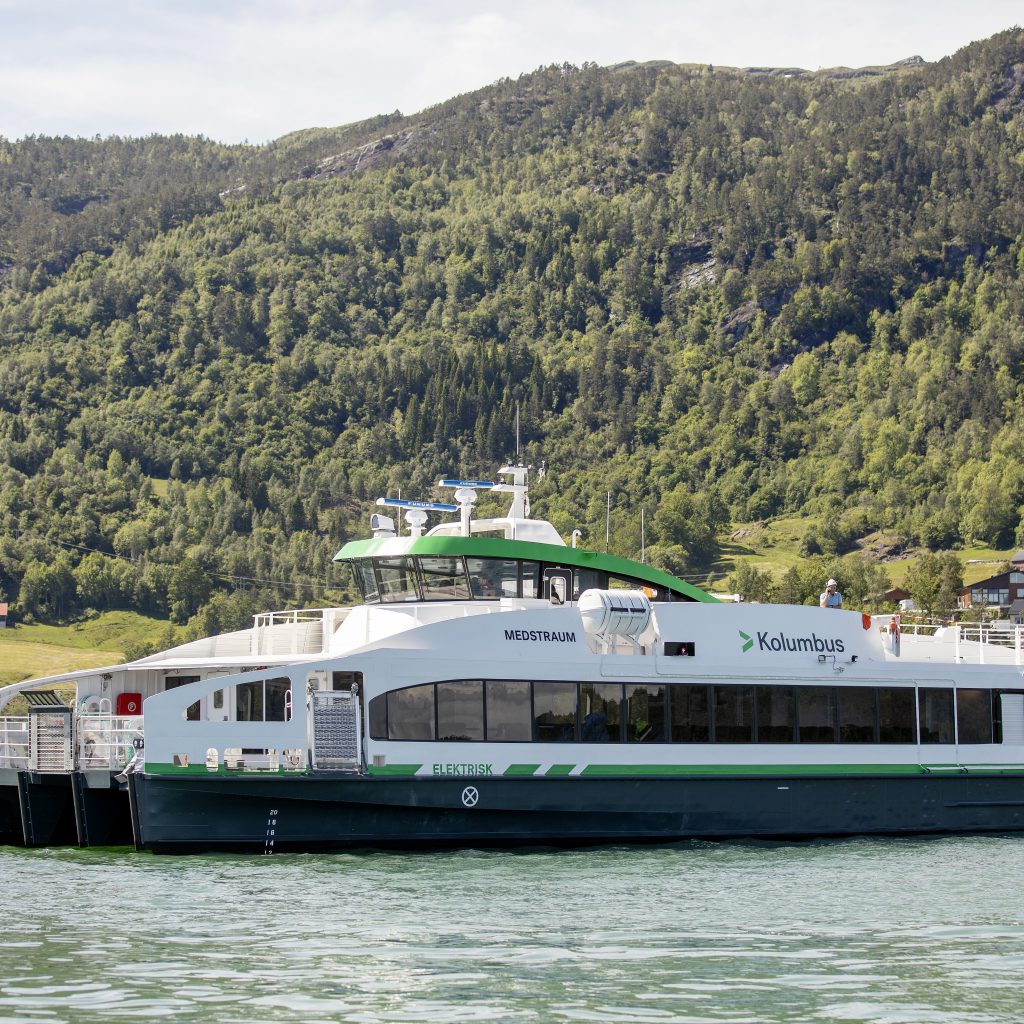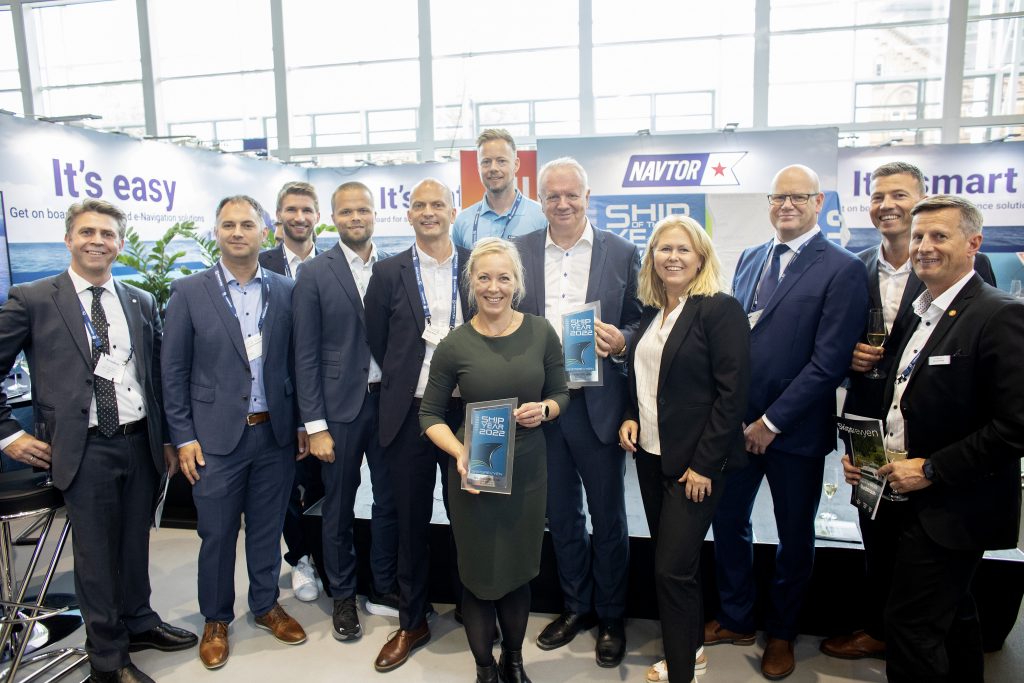The world’s first battery-only high-speed craft, MS Medstraum has been awarded Ship of The Year. Ship builders Fjellstrand Verft and shipowners Kolumbus, a Norwegian public transport company, received the price at an official ceremony at SMM Hamburg on Tuesday 6th of September.
Ship of The Year, Medstraum, will soon start operating a multi-stop commuter route in Rogaland, Norway. This pilot vessel is a result of the EU-funded TrAM project, instigated by Maritime CleanTech, led by Kolumbus, and partly funded by Rogaland County Council. The TrAM project aimed to develop a zero-emission fast-going passenger vessel through advanced modular production.
– It is a great honour to receive this award for “Medstraum”, the world’s first fully electric express ferry. I am proud that we, together with Kolumbus, all the partners and Fjellstrand have succeeded in building a fantastic vessel that will mean so much for those depending on her to get them to work, school and holidays, County Mayor of Rogaland, Marianne Chesak, said under the ceremony.
Annual award
Ship of The Year is an annual award handed out by Norwegian shipping magazine, Skipsrevyen. Their readers suggest candidates for the prize before a jury makes the final decision. The aim is to honour a shipbuilder, a ship owner, and their design for setting a new standard within green shipping.
– Ship of the Year 2022 goes to a vessel that not only offers many technical innovations but also has great transfer value to other vessels in this group, as well as in the maritime sector in general, Skipsrevyen states in their press release.
– Medstraum is historic as the first battery-only vessel to pass the magical 23 knots limit, which is required to be classed as a high-speed craft. In this case, it has been done by good margin. During tests, the vessel has achieved a speed of 27 knots, Skipsrevyen writes.
Whilst traditional fast ferries running on fossil fuels are known for being highly polluting, Medstraum will vastly improve the carbon footprint of its owners, Kolumbus, a public transport company.
– Medstraum will cut our emissions by 1500 tonnes a year, despite operating on our least energy-demanding route. That’s the equivalent of 60 buses, Project Manager at Kolumbus, Mikal Dahle, says.

Revolutionary modularisation
The vessel is also revolutionary in terms of simplified design and using unique modular manufacturing methods at the Norwegian shipyard, Fjellstrand, drawing on Fraunhofer IEM’s experiences in modular production techniques from the car and aviation industries. Modularisation helps cut both production and engineering costs and will contribute to making electric-powered high-speed vessels competitive in terms of cost and the environment.
– It’s been challenging building this ship, as it’s never been done before, but we’ve learned a lot. Fast ferries require a lot of energy, so we needed to make Medstraum lighter and a lot more efficient than traditional fast ferries. We’re very happy and proud to have accomplished that. It is revolutionary that a vessel of this size can operate at 23 knots for an entire hour by electricity alone, says Edmund Tolo, Head of Research and Development, at Fjellstrand AS.
No fossil fuel backup
The vessel is equipped with 2 x Corvus Dolphin Power Lithium battery systems for propulsion and hotel load. Medstraum is powered by batteries only – no fossil fuel backup. The batteries are arranged above the deck to enhance the safety of the systems and ensure easy access for maintenance. Wärtsila Marine has delivered the integration of batteries, propulsion, and electric onboard systems.
A brand-new propulsion system
In the project, the National Technical University of Athens (NTUA) and Hamburg Ship Model Basin (HSVA) have investigated hundreds of different hull forms to ensure that the TrAM project vessel will become as efficient as possible.
Servogear has delivered a newly developed propulsion system, the Ecoflow el-flow system. This consists of a turning propeller, rudder, shaft, carbon brackets, gears, and propeller tunnel design. The delivery is based on standard solutions but optimized specifically for the hull, weight, and hydrodynamics of Medstraum. The fast ferry has a propulsion efficiency of around 80 percent, which is groundbreaking for this type of vessel. Measured against a standard solution with a water jet or fixed propeller on a similar hull, the energy saving is almost 30 percent.
Light framed
Leirvik AS manufactured the wheelhouse and passenger module in aluminum supplied by Hydro. When constructing a fast ferry, it is crucial to keep the weight as low as possible. Some of the aluminum structures used at Medstraum were down to a thickness of just 2 millimeters. Here, Leirvik used their expertise in building residential quarters in aluminum for use offshore, in new areas.
Fjellstrand Shipyard in Omastrand, Norway, has built the aluminum hull, assembled the various modules, and equipped Medstraum.
Exploiting the technologies in the market
Ship of the year Medstraum will soon start operating a multi-stop commuter route in Rogaland, Norway. The TrAM project is also conducting studies on the possible use of technologies in River Thames, London, and on the canals in Belgium.
Project partners: Maritime CleanTech (NO), Kolumbus (NO), Rogaland County Council (NO), Fjellstrand (NO), Leirvik (NO), Hydro (NO), Servogear (NO), Wärtsilä (NO), HSVA (NO), University of Strathclyde (GB), National Technical University of Athens (GR), Fraunhofer IEM (DE), Uber Boat by Thames Clippers (GB) and De Vlaamse Waterweg (NL).


